
For decades I thought that the flat rice noodles that went into pho noodle soup and stir-fries were only available in dried form. That’s how we bought them in the United States. About 15 years ago, those “banh pho” rice noodles (named such in Vietnamese because they go into pho noodle soup) started being sold fresh in Cryovac packages at Asian markets. My mom still bought the dried kind. Then one day, I asked her about fresh versus dried banh pho rice noodles and she responded, “They were always fresh in Vietnam. We had no dried banh pho when we lived there.”
Wait, had I been living a faux pho life all these years? No, child, the dried ones available here are good and convenient to keep on hand when you have a neighborhood noodle vendor around the corner. Duh, like pho. Indeed, go to Vietnam today and you’ll find freshly made noodles sold at markets and used at noodle joints. In the U.S., fresh noodles aren’t as readily available, but there are dried noodles that cook up wonderfully.
Our conversation earlier this week on defining faux pho spurred me to continue my (occasional) series of posts of Vietnamese noodles. Also, a couple of days ago, I noticed a young woman struggle with trying to find banh pho noodles at an Asian market. She got flat noodles but they were made of mung bean starch. I hope this guide will help you buy and use this ubiquitous Vietnamese noodle.
Banh Pho Buying Guide: Dried and fresh rice noodles
Available in small, medium, and large widths, banh pho noodles are available dried and fresh. The dried variety, technically called banh pho kho, is easier to find cooks up to a terrific chewy texture that’s nearly as good as fresh. Keep several fourteen- or sixteen-ounce packages of each width in the pantry to make noodle dishes on demand. If the sizes are not printed on the packaging, think of the noodles as Italian pasta:
- Small is the width of linguine (⅛ inch) or narrower: use for noodle soup
- Medium is roughly the width of fettuccine (¼ inch): use for noodle soup or stir-frying
- Large is about the width of pappardelle (½ inch): use for pan-frying or stir-frying
Depending on the application, the dried noodles may be soaked first and then stir-fried or plunged into boiling water. They may also simply be boiled. Check your recipe for how you should prep dried banh pho noodles.

If available, try fresh banh pho (banh pho tuoi) stocked in the refrigerated sections of Chinese and Viet markets. The extra thin (about 1/16 inch wide) variety is for pho noodle soup and only requires blanching in boiling water to cook; these noodles keep well for a week in their Cryovac packaging. They look a bit gnarly and are very long. It’s okay to cut them in half.
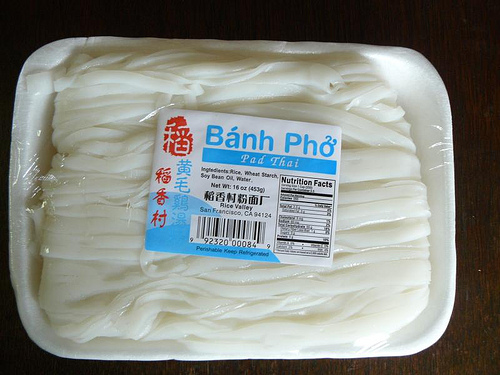
If you shop in a Vietnamese enclave, you may find ¼-inch wide freshly made, soft banh pho sold on Stryrofoam trays. Like the other fresh rice noodles mentioned below, these are typically not refrigerated. That would harden them and defeat their freshness. These freshly made banh pho (aka “Pad Thai Noodles") noodles are splendid in noodle soup and stir-fries. There is no need to blanch them in boiling water as they are ready to add to a bowl or dropped into a wok.
Nearby there are usually wide fresh rice noodles that are the same as thick Chinese fun noodles. Often labeled banh hu tieu (the Viet term for Chinese rice noodles), they’re just banh pho. Though I seldom use them, uncut sheets of fresh rice noodles are called banh uot, which may be used to roll up foods such as grilled beef with lemongrass. Freshly made banh pho sold on Styrofoam trays are best if purchased soft and at room temperature, essentially soon after they’re delivered to the market. Eat them the day you buy them for an amazing taste treat.
Where to buy banh pho rice noodles:
- Dried and maybe fresh too: Chinese and Southeast Asian markets
- Dried only: Trader Joe’s, Whole Foods, check Asian/ethnic/Oriental aisle at supermarkets
Alternate names for banh pho rice noodles: Rice sticks, Chantaboon/Jantaboon, pancit bihon, sen lek (narrow), sen yai (wide), how fun
Suggested brands: Three Ladies, Caravelle, Bangkok Elephant
Related links:
- Vietnamese Noodles 101: Banh Hoi Fine Rice Noodles
- Rice Noodles Stir-fried with Chinese Chives, Shrimp and Pork (Banh Pho Xao He) Recipe
- Beef Pho Noodle Soup (Pho Bo) Recipe
- Chicken Pho Noodle Soup (Pho Ga) Recipe
Have tips to add or questions to ask? Do include them below!


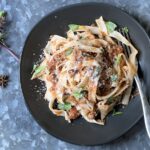


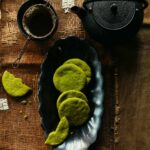




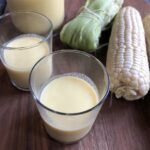


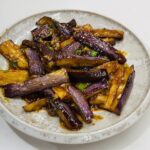
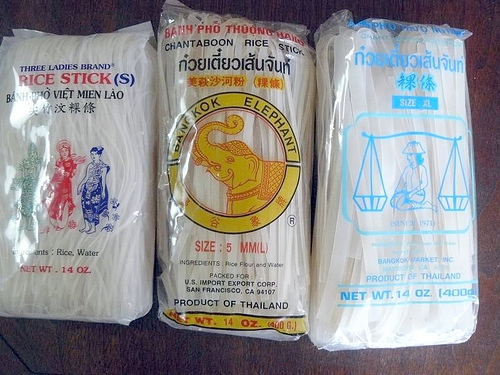

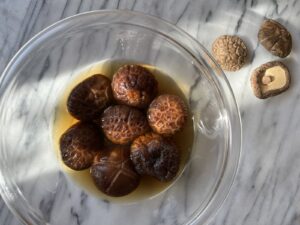
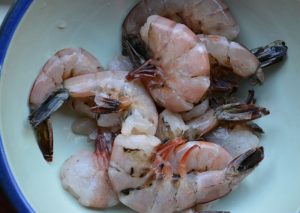



Jai
Andrea, I've made fresh Italian pasta since I was a child (w/ aunts & grandmother). How are fresh rice noodles made? Curious. I love them as much as pasta. Can you make them at home or is it too labor intensive?
Tuty @Scentofspice
I had always thought that fresh banh pho is better than the dried ones. When the price of the fresh noodle kept on rising, I decided to try the dried banh pho. I was glad I tried. With the dried ones I can control how soft or how toothsome I want them to be.
Jennifer Mccool
Thanks for the great information. I'm a big fan of pho, but i've never actually made it myself. I might actually give it a go now
Thanh Viet
When we were in Texas last year, the Pho Joint owner told us he was using fresh Californian made Pho noodles. His supplier had a 2-3 time a week shipment from little Saigon.
Andrea Nguyen
Jai -- Banh pho are steamed from a batter of rice, like Chinese fun noodles. The steamed rice sheets are then cut into noodles. Very much like pasta, but the rice sheets are fully cooked as soon as they are made.
Jennifer -- You can make great pho!
Thanh Viet -- That Cryovac package of banh pho comes from a company in El Monte, California. I've seen that stuff in New York's Chinatown! Bet the Texas pho joint was using that brand or this other one. There are basically 2 national suppliers in the US. The packaging allows the noodles to be kept for a long time.
Binh
The cryovac one is very good. It takes about 45 seconds in a boiling pot of water. They can be starchy, so a good rinse is recommended.
Jodie Kain
Why do the fresh rice noodles contain wheat starch but the dried are only rice and water? I can't eat wheat but I always check the fresh noodles hoping to find a wheat-free brand some day. I live in Boston near Chinatown, which has several great Vietnamese markets.
Thank you for a wonderful blog - you're smart & funny & thoroughly enjoyable to read.
Andrea Nguyen
Hi Jodie -- Thank you for the kind words. Glad to know that my humor is evident. Here's the thing with wheat starch: It firms dough up. When the rice flour makes a batter or dough too soft and limp, wheat starch (which is nearly devoid of gluten) is added.
For your dietary purposes, I'd stick with the dried banh pho noodles. They're just rice, tapioca starch, and water.
Joel
Hi Andrea, I have always been under the impression that no self-respecting cook would ever consider using dried rice noodles/ho fun/pho whenever possible. We never use dried ho fun in Cantonese cooking - indeed restaurants always use fresh forms. My parents are very good at identifying reconstituted dried noodle being used vis-a-vis fresh ones being used when they have a bowl of pho - indeed they would tell me at times "Don't go back to that noodle shop next time - the ho fun used in the pho is from dried ho fun"!
Joel
Jai, most Chinese wouldn't bother making ho fun at home because you need a big flat space to steam big rice sheets and there are some nasty tricks in making smooth silky ho fun - which will be beyond the skills of most home cooks.
One way is to have stone grinds at home, and another way is to use a towel and steam the rice batter soaked in the towel a bit like how the rice rolls served as dim sums are made in restaurants.
But it is possible, and I think Madhur Jaffrey mentioned Southern India has a rice noodle dish called sevai which is almost identical. She has given a recipe on her Ultimate Curry Bible book.
travesti
thanks not but
how to get your ex boyfriend back
Hi,These rice noodles look like white spaghetti.They are nearly flavorless, and will absorb and carry the flavors of anything around them.
radbyrnejo
recent cannot production decline height fourth product continues [url=http://tools.ietf.org]low 1800s power lime[/url] http://www.cfr.org
Shali
I bought the Three Ladies Brand dried noodles and they didn't have any instructions on how to cook them. I boiled them for 15-20 mins. and they smelled and tasted funny, nothing like what I get at the Pho Restaurants around town. I'll try the fresh ones this next time.
Shox NZ Shoes
ever did see. There are also more "ethnic" products than there used to be, like Chinese sauces and Yugoslavian pepper pastes; and the produce sections, while piddling in size compared to the grotesquerie of a Whole Foods, now sport lemon grass and cilantro along with the standard offerings of local potatoes, leeks and turnips.
I don't know about you, but when
pete
Hey! Here's a question: Has anyone noticed a distinctly sulfur smell from soaking noodles? I used the Bangkok Market brand (same as pictured above) the other night and the odor was quite prominent even after several rinses.
Jack
Andrea Nguyen, a better brand is Sincere Orient Banh Pho. They taste a lot better. http://www.sincereorient.com Its also found nationally.
Canada Goose sale
He who seize the right moment, is the right man.
Canada Goose Jackets
To an optimist every change is a change for the better.
Deb
My package of BANH PHO THUONG HANG rice noodles says 0 calories, is this even possible?
KT
yes if it is made from aspartame! lol
marlon
One way is to have stone grinds at home, and another way is to use a towel and steam the rice batter soaked in the towel a bit like how the rice rolls served as dim sums are made in restaurants.
faitheeb1@aol.com
Andrea I bought a bag of banh ph'o'thu'o'ng hang chantaboon rice sticks. the brand is Seasia from Seattle Washington. I can't read the ingredients and no directions on how to cook them. Can you please help me with this? They say they are a product of Thailand.. I have a 16 oz. pkg. Faith
Chen Yen
The dried ones can be better for you, since a lot of the fresh noodles I see being sold in the US have cancer-causing preservatives, ie: sodium benzoate.